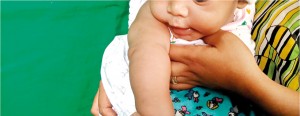Nerve injury: Early intervention the key
There is a newborn in the home and the parents are happy and contented. If, however, it has been a difficult birth, while enjoying the latest addition to the family, there is a need to be watchful for a common issue that may be lingering.

'Waiter's tip' posture when three nerves are affected
In the weeks and months which follow a difficult birth, check out the shoulder and hand movements of the newborn, explains Consultant Plastic Surgeon Dr. Thushan Beneragama who is attached to the National Hospital in Colombo.
A “difficult” birth may be the result of the baby being large when compared to the mother’s size or being in a breech position, he says, pointing out that both these situations could lead to forceps or a vacuum being used to aid the delivery. When a baby’s buttocks and feet are positioned for delivery, instead of the usual head, it is a ‘breech’.
“During delivery, the priority is to get the baby out and in situations where the baby is either big or is in a breech position, traction has to be applied. This could cause the baby’s head to move in one direction, while the shoulder moves in the opposite direction,” says Dr. Beneragama. An obstetric brachial plexus injury could ensue, MediScene understands.
With the brachial plexus being a network of nerves that emanate from the spinal cord to the shoulder, arm and hand, Dr. Beneragama points out that the traction during birth could strain these nerves, make them break partially or snap them apart completely.
Separating one from the other, this Plastic Surgeon says a strain may improve with time, within a couple of months of the birth, while a partial or complete break may show some improvement or no improvement at all.
Something being wrong with the brachial plexus would be evident if the baby is not moving the shoulder, the elbow or the hand or all three, it is learnt.
Diving into the intracacies of the nervous system, he says five nerves generating from the spinal cord are embedded in the upper limb. In a difficult birth there could be damage to two, three or all five of these nerves.
A good pointer to how many nerves are injured:
There would be no shoulder movement or elbow bending if two nerves are affected.
There would be no shoulder movement and no elbow bending, while the wrist would be flexed (bent), if three nerves are involved. Here the hand would be dubbed as a “waiter’s tip posture”.
There would be no movement at all with the entire limb being flail (waving or swinging), if all five nerves are affected.
When seeing the baby for their regular vaccine shots, it would be the Paediatrician who would usually spot the issues with the limb and refer to a Surgeon, who in turn would monitor the baby, be it a strain, partial or complete break and ascertain whether there is recovery and also whether such recovery is adequate, it is learnt.
Some babies who are having obstetric brachial plexus will recover fully but it is important to monitor the progress, MediScene understands. In those who don’t make a complete recovery it is vital not only to intervene but also know when to intervene.
“Early intervention is always better,” stresses Dr. Beneragama, pointing out that the smaller the baby is, it would be better, as no nerve procedures get good results when a child is big.


